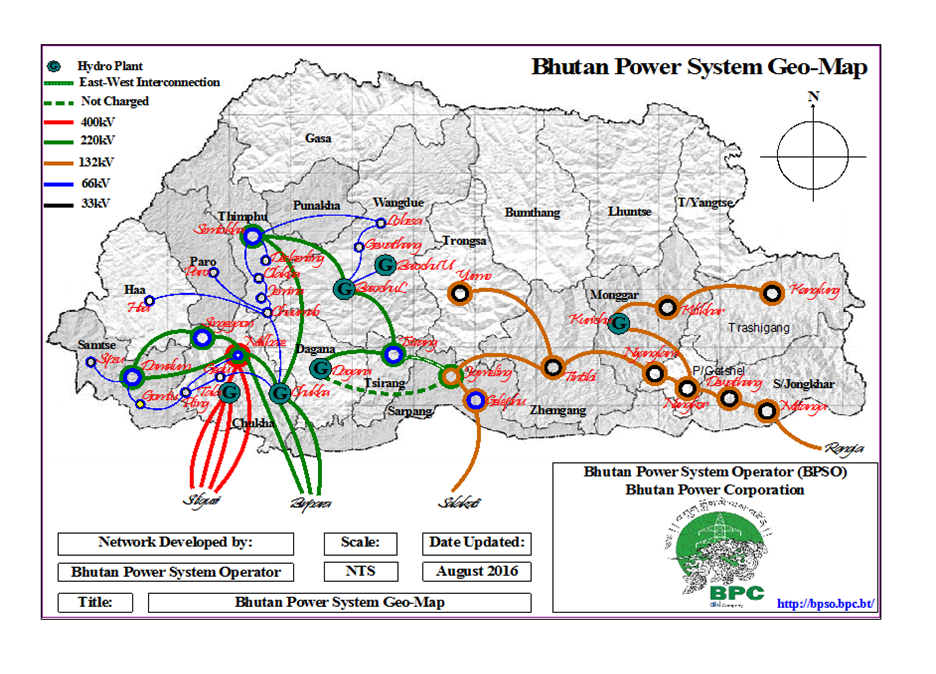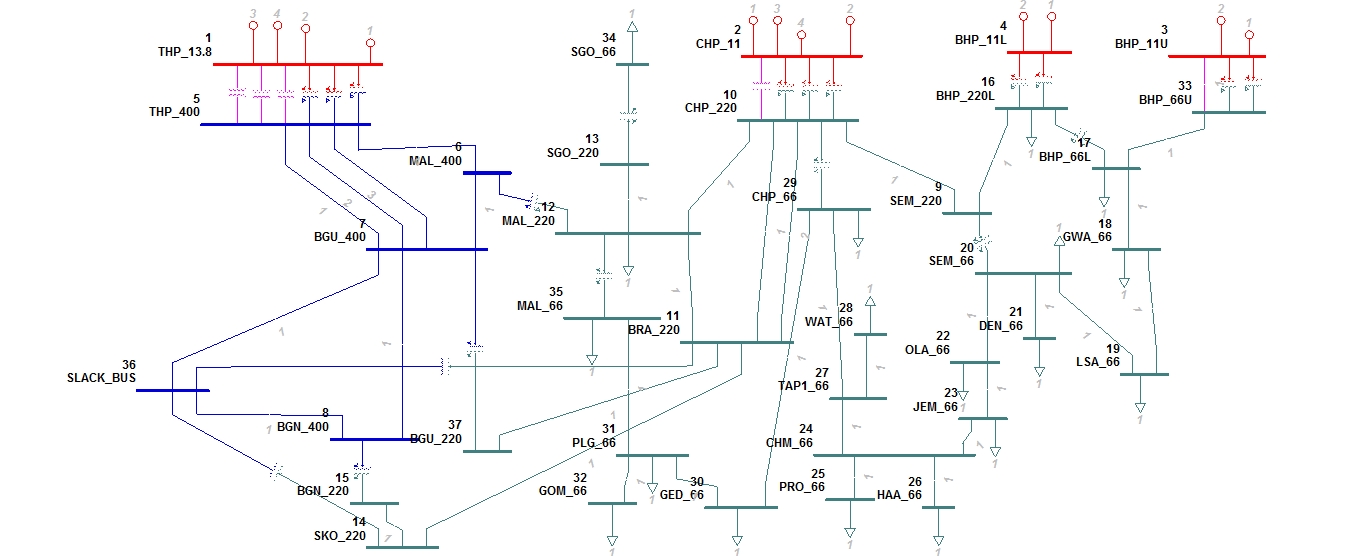Projects:2016s2-215 Bhutan Power System Islanding and Special Protection Devices
Contents
Abstract
In this industrialized world, the interconnection of power transmission and generation is ever increasing. The increasing load is forcing power systems to operate closer to their stability limit. If appropriate actions are not taken timely, this ramping load and high degree of interconnection can lead to cascading failure which can result in total power black outs. Power blackouts not only causes inconveniences to the customers but can cause a huge monetary loss to the industries and to the nation.
In a large interconnected power systems network, the system tends to split into smaller sections during the disturbances due to the tripping initiated by grid protection system. This is an unintentional formation of island and has a potential to damage equipment and weaken power system security. To prevent unintentional islanding, it is important to form forced controlled islands which are achieved by generation or load shedding.
The objective of this thesis is to identify how Bhutan Power System (BPS) would effectively island from Indian grid when there are disturbances outside BPS. Reliability of Bhutan power system depends on the stability of Indian grid due to large interconnections. With the present scenario of transmission network, BPS is not able to safely island from the Indian grid during the disturbance / outage of the Indian grid.
The methodology adopted for this study is through Contingency Analysis which is basically a “what if” scenario that evaluates the impact of contingencies on the electric power system. In this thesis, Load flow and contingency analysis has been carried out in PSS®E simulator to create scenario of controlled island.
Bhutan export power to India. Currently there are nine international feeders connecting Bhutan and India at 132 kV, 220 kV & 400 kV level. The fault outside Bhutan results in tripping from the Bhutan Generation whereby causing black out in the Country.
In this project, case studies shall be carried out on how the Bhutan power system could effectively island from Indian grid connection when there are disturbances in any part of the grid outside Bhutan. This would ensure reliability to the entire connected grid. Studies on protection devices for incorporation into the transmission system for efficient system operation during contingencies shall be carried out.
Introduction
Electrical circuits failure due to fault in one of the circuit elements causes the cascaded tripping of other element which ultimately leads to power system black outs. This uncontrolled outage causes damages to the transmission equipment, power plant, interruption to the production cycle of the industries and a huge financial loss to the concerned company or the country. It is known that the faults in the power system are unavoidable; however, the power outages due to faults can be eliminated if the system is properly studied and strategically installed an appropriate device in the right location. Therefore, studies in this paper is focused and detailed more on the methods of is-landing or isolating the power system grid from each other during the disturbances in one of the interconnected grids.
Motivation
The motivation for working on this topic is the inability to island Bhutan Power System under contingencies to feed Bhutan’s domestic load without the Indian Grid. Numerous blackouts that occurred in Bhutan in recent years were due to interconnected international transmission lines fault or fault in Indian Grid. Currently, how much ever surplus generation the Bhutan has, the export of surplus generation is entirely dependent on the healthiness of the export feeders and Indian Grid. Even though, during the failure of the Indian grid, export may not be possible, but if proper is-landing of the Bhutan system is in place, Bhutan domestic load can still be fed without the Indian Grid. Besides, complete is-landing of the Bhutan system from Indian grid can be avoided, if the contingency analysis of the export feeders are studied and accordingly installed special protection devices to load shed or back down to avoid cascaded tripping.
Previous Studies
In general, research and study for power system is-landing formation and observations has been started long way back. Large number of papers and literature on application of different schemes for load shedding techniques and is-landing approaches are reported to prevent power system black outs. However, feasibility study for power system is-landing for Bhutan Power System (BPS) is a new project that we are undertaking. The knowledge gained from literature review can be applied to study and implement to BPS.
Objectives
The main objective of this project is to “Identify how BPS would effectively island from international connection” when there are disturbances outside BPS. It is aimed to achieve this objective by carrying out:
- Study of possibility of automatic signal generators and its generation control during sudden increase/decrease of load due to system outages.
- Frequency response of the generators on regional grid outages and independent supply of local loads.
- Study on the Protection Devices (PD) for incorporation in the generation/transmission system for efficient system operation during contingencies.
- Study of Phasor Measurement Unit (PMU) for system
Methodology
Date Collection:
The real time data for Bhutan Power System has been collected from the System Operation Office, Bhutan Power Corporation Limited, Bhutan as this office looks after the power system operations in Bhutan. The data required for this project were generation data, transmission line data and network data.
BPS Base Case Model Development:
The Bhutan Power System has been modeled in PSSE based on the available power system data received from the Bhutan power company.Since, the Bhutan power system is a small grid which is connected to giant Indian grid through 7 exports lines from the western grid, the Indian grid has been modeled as a slack bus in our study model and also the Indian grid parameters were not available. It is basically intended to simulate and understand the load flow behavior of the system during the tripping of exports lines or Indian Grid failure.
Model Validation:
For validating the Model, the Real time Generations and substation coincidental loads on high voltage substations were collected from the Bhutan Power System Operation office and fed in the Power System Model.For Validation, the real time line flows from the generation end, major substations in Bhutan have been collected for a particular dates. The flow result obtained from the Bhutan Power System Model simulation was compared with the real time generation and lines flows.
Analysis & Result
Contingency Analysis Simulation:
- 100% Generation Loading:
- 75% Generation Loading:
- 50% Generation Loading:
- 25% Generation Loading:
Summary of the contingency study Result
From the above contingency studies, it is learned that Bhutan power systems do not have the scarcity of generation problem. It has the problem of load scarcity with huge surplus power export to India during the isolation of Indian grid due to a fault either in the Indian grid of fault in one of the export lines. The finding of the study result is summarized based on the availability of the generation which is detailed below:
- 100% Generation: from the contingency study result it is found that during full generation, failure / tripping of 1 no. of 400kV export feeder and 1 no. of 220 kV export feeder to India pushes a Bhutan power system grid to an emergency stability limit. Hence, tripping of any remaining export feeders overloads an existing transmission line which leads to cascaded tripping of lines and generators.
- 75% Generation: when the generating units in Bhutan generate 75%, it is seen that minimum of 2 nos. of 400 kV lines and 220 KV lines are required to safely evacuate the surplus power to India without getting the lines overloaded. However, from the studies shows that 400kV export lines are loaded near to their maximum carrying capability limits (90%) at this generation.
- 50% Generation: from the studies, it is seen that to evacuate the surplus power to India when Bhutan system is generating 50%, minimum of 2 Nos. of 400 KV export lines and at least single 220kV export line are required.
- 25% generation: at this rate of generation in Bhutan, it is learned that there is a surplus export of around 50MW to India. In case of complete Indian grid failure, the Bhutan grid will trip on high frequency. However, when the 400kV / 220 KV transformers trips in Bhutan system, it imports from India some amount of power from the 220kV side to feed the Bhutan load. Under this situation, tripping of 220 kV line would trip the Bhutan grid on low frequency.
Use of Special Protection Device to island Bhutan Power System
From the studies, it is learned that most of the Bhutan power system is tripped due to over loading of the transmission lines when there is a fault either in export transmission lines or fault in Indian grid due to surplus generation. From the remedial measure studies, it is learned that the over loading of the transmission line can be avoided if the predetermined generation unit is automatically shut down when there is a tripping of certain combination of export lines. accordingly installation of following special protection devices have been recommended:
- Installation of special protection devices like inter-tripping relays [3] at the generation end would safely island the Bhutan Power system. These inter-tripping relays can be installed in the export feeder at the generation station and export substation end and another relay with the generating units.
- Installation of Under Frequency Relay at the load end[2]. This relay automatically trips when the frequency set to that relay is equal to the power system frequency. Hence, the breaker trips and the load is automatically reduced during the deficit of generation.
- Setting up an operational procedure to restore [1] the system from the emergency state of operation to normal operation state once the faults have been rectified. The restoration procedure can be set up based on the power system constrains in the Bhutan power system.
Future Works
The future work of this project would be studies on implementation of smart protection devices such as, inter tripping relays, under frequency relays and PMUs. Besides, it is also require to study on the restoration procedure to restore the system from emergency state to normal state by studying the system constraints and critically ranking the contingencies by using Linear Sensitivity Factors.
Conclusion
In order to accomplish this project result, it not only requires the power system engineering knowledge, but also the knowledge on power system software tools for developing the model and simulation to analyze the result.Hence, this project to island Bhutan power system from the Indian grid is one of the best projects which gives not only to learns the power system, but also the power system software tools and working of special protection devices. The objective of the project to study the methods of is-landing the Bhutan power system has been achieved. from the studies, it is learned that the Bhutan power system always have the generation surplus which is exported to India. However, the Bhutan grid trips along with the fault of Indian grid due to overloading of the export line especially during peak generation. Therefore, it is still left to study and implement the special protection devices to verify the study result practically in the field.
Project Team
Team Member
- Chhador Phuntsho
- Sherub
Supervisors
- Professor Michael Liebelt
- Mr. Matthew Trinkle
Resources
- [1] Sumi Soman; Polly Thomas; John George; Ganesh M. “Prevention of blackout by effective forced islanding and restoration scheme”. 2015 International Conference on Emerging Research in Electronics, Computer Science and Technology (ICERECT), Issue Date: 17-19 Dec. 2015.
- [2] Lakra, Pradeepti , Kirar, Mukesh, “comparison of Under Frequency Relay based and Frequency Response model based Load Shedding scheme”, 2015 Annual IEEE India Conference, Dec. 2015, pp.1-6.
- [3] Ahmed Awad, “Network Protection and Automation guide 2011” ALSTOM Grid, PP. 8.1-8.9.